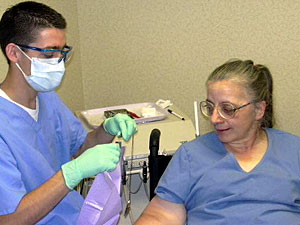|
Photos
Your Voice
|
Access to dental care a problem for low income people in rural Minnesota
January 27, 2004
 |
| Sharon Stanley prepares to have her teeth cleaned. She says, if the dental clinic staff didn't come to her nursing home, she probably wouldn't get dental care. (MPR Photo/Bob Reha) |
Moorhead, Minn. — It's a busy day for the crew from the Apple Tree Dental Clinic in Hawley. Today they're visiting a Moorhead nursing home where they'll see 30 patients. This Moorhead care center is one of nine locations the dental staff visits every month. Sharon Stanley is waiting for her turn in the dentist chair. Like most of the folks with an appointment today, she's confined to a wheel chair.
"I would probably lose all of my teeth because I would not go," says Stanley. "I have an electric chair I could go, but it's much easier to do it here. Because I have to have a handicapped van to do it (travel for an appointment)."
The Hawley clinic is affiliated with a Twin Cities dental program. Since 1998, the non-profit clinic has become the only place in this region many low income people can get dental care.
"Northwestern Minnesota has maybe one of the most severe access problems (to dental care) of the whole state," says Ebert.
Carl Ebert, director of community dentistry for Apple Tree Dental, says as the rural population has ages dental care becomes even more important. However as dentists in the region retire, no one is replacing them. Ebert says if not for the clinic many people would receive no dental care. He says that could lead to bigger problems.
"Bad oral health, in terms of periodontal disease or gum disease, is a major concern for people that have heart conditions," says Ebert. "And (dental disease) can actually precipitate certain problems with the heart."
Ebert says the goal of the Hawley clinic is to provide care for people who can't afford it. The clinic's patient load has grown steadily. In 1998, the clinic had more than 1,300 patients. Five years later the patient population has more than doubled. Dan Boedigmheimer is dental director at the Hawley clinic.
"We could stay open 24 hours a day and triple our staff and still have plenty of extra work to go around," says Boedigmheimer.
 | |||
People just don't come to the clinic in Hawley. Suzanne Horn, office manager of the clinic, says some of the patients drive hundreds of miles to get to the clinic.
"When we ask them why they come the four hours to come to Apple Tree in Hawley they say because I can't find a dentist in my area that will take my insurance," says Horn.
Horn says that's a big problem. She says many dentists refuse low income patients. Most insurance companies don't pay the full cost for care. The clinic's patients can't afford the co-pays. Dan Boedigheimer is director of dental services in Hawley. He says it's a situation many dentists want no part of.
"The more work that a particular dental office does on low income, the more in debt that particular dentist becomes," says Boedigheimer.
The Hawley clinic has received enough grants and donations to avoid a debt problem. Clinic officials say it's a challenge to find dentists who are more interested in helping people than making a profit.
They say providing service for low income people will only get tougher. State programs providing aid for health care have been cut. Most dental benefits are capped at $500.
Clinic officials are hopeful some of the state funding for low income dental programs can be restored.
|
News Headlines
|
Related Subjects
|
